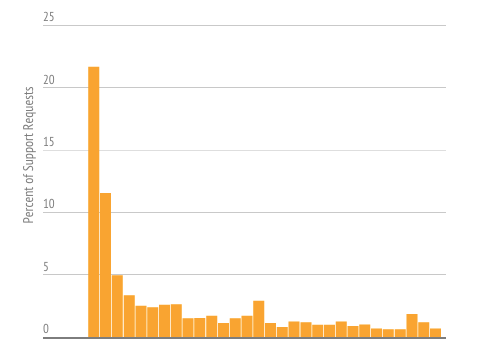Backer support is one of the major problems that blindsides project creators when they end their first successful campaign. You barely have time to celebrate meeting your campaign goals before you’re suddenly deluged with backer support requests. “Can I change my pledge level?” “When will you ship?” “I wasn’t able to get my pledge in on time–can I still place an order?” “When will you survey?” “What shipping method will you use?”
The task seems manageable at first. Write a few comments, post some updates and everything will be fine, right? Pretty soon you realize that not all backers read updates and, even worse, there’s a select few that read updates, misinterpret the message and then wreak havoc in the comments. Now you’re spending time each day responding to backers just trying to keep the crowd under control.
That’s why we made backer support a primary focus here at BackerKit. We’ve built our system to handle the most common backer needs. We take care of the reward-related requests by offering pre-orders, add-ons, pledge level upgrades, and reward selection via pledge question. Our self-service survey and FAQ allows backers to help themselves if they need to edit a survey response. We’re so confident in BackerKit’s ability to mitigate support requests that we take over front-line support for our project creators at our most popular service levels.
Tracking Support Tickets
We started actively logging backer support ticket statistics earlier this year to collect data about the support request rates across all projects and for individual projects. Tracking this data allows us to study how feature updates affect how often backers send in support requests. We thought it would be fun to share some of the stats!
From March through July of this year, we had 212 support-enabled projects go live on BackerKit with 436,640 total backers and we’ve received 6,992 support tickets from those backers. That comes out to 1.6 support tickets for every hundred backers. That ticket rate is deceptively low because it includes projects that just started surveying in July–we haven’t given those backers enough time to send in their support inquiries.
If we narrow the scope to only include support-enabled projects that started surveying in March 2015, we end up with 35 projects with 90,422 backers and 2,015 support tickets for a 2.23% ticket rate or 2.23 support tickets for every hundred backers. That’s not bad considering that most of these projects have had surveys out for over five months and several have already shipped out rewards.
Our 2.23% support ticket rate is a hard-earned number. It doesn’t include the support tickets that our self-service survey system preempted or the tickets that never happened due to the work our customer success team performed behind the scenes helping project creators set up their surveys correctly.
Let’s take a look at what percentage of support requests come in during the days right after a project creator sends out surveys:
Support Ticket Distribution (Days after Survey)

Days after sending surveys
We get an initial rush of support emails when surveys first go out. In the first 60 days after a project creator sends out surveys, 21.68% of support tickets will come in on the first day the survey goes out, 11.56% on the second day, 4.95% on the third day and the percentage continues falling as more backers complete their surveys.
Most backers respond to the survey in the first few days and then the response rate tapers off until lock-down day when the final stragglers answer their surveys. We see a slight bump around day 15 because many projects will lock down surveys after two weeks. It turns out that the number of support tickets we receive on the first day is slightly more than all support tickets we receive from days 30-60.
We Have Skin in the Support Game
We handle front-line support for all projects on the Standard, Entrepreneur, Premium and Enterprise plans so we’re motivated to make sure that backers have the best experience possible. If backers get confused or have questions during the survey process, they send in support inquiries which creates work for our support staff.
That’s part of the reason why we put so much effort in working with project creators to make sure they itemize their pledge rewards and set up their pledge levels correctly. We guide creators on best practices for pledge questions, add-ons, shipping fees, and everything else to make sure that surveys are perfect before sending them out to backers.
We try to enforce these practices to ensure that project creators get fully structured data without having to parse orders by hand but the other goal is to have surveys come out polished and easy for backers to understand. We actually guide our Simple Plan projects through the same process because we want all backers to have a positive experience using BackerKit even if the project creator isn’t using us for support.
Guiding Creators Up the Mountain
Creators that have gone through the survey building and review process with us will tell you that we’re like survey sherpas. We’ve climbed this mountain over a thousand times and we’ve seen just about everything that can go wrong. We can tell you what works, point out potential pitfalls, and show you the little tricks that will make your life easier. We’ve built our BackerKit system and our processes to keep projects safe through the entire journey.

Our system sends out an email alert to the BackerKit team when a project creator clicks “invite” to send out their surveys. We closely monitor the initial support tickets for every project because the early support requests can identify problems that can usually be fixed with a quick survey edit. Common problems include accidentally omitting a stretch-goal item, forgetting to add a pledge question to allow backers to select which version of an item that they want, or forgetting to make certain add-on items available.
Safe Recovery
The BackerKit survey has a built-in safety net that allows creators to make changes and backers can go back to their surveys any time before their survey is locked down to change their responses or answer new questions. This makes it simple to recover from survey mistakes. Compare that to making an error in the Kickstarter survey, where you’d have to create a spreadsheet to track new responses because backers can’t return to edit their Kickstarter survey answers.
The combination of good surveying practices, live support ticket monitoring, and self-service editing for backers allows BackerKit to keep support under control for project creators.
Ultimately, we want all project creators to spend their time on making amazing things rather than responding to emails and editing survey responses. Let us know if you agree. How many support tickets did you have to handle after your project ended? We’d love to talk!
